With margins as tight as ever,, modern livestock systems need to grow and utilise as much grass as possible. There are a number of methods in which old or underperforming grassland can be rejuvenated. After all, it pays to keep grassland right given that it is the cheapest source of feed for farmers.
Telltale signs that a sward is in need of attention include poor grass quality, slower response to fertiliser, lower yields and a presence of weeds. Poor weather conditions, poaching and traffic from heavy machinery can lead to soil compaction.
If you’re looking to give your pasture a new lease of life, the traditional plough, till and sow method is not the only option. As with most situations, there is no one-fits-all solution. Depending on the situation, methods such as stitching in and soil aeration can provide good results at a reduced cost.
In some cases, ploughing may be the only option in scenarios where land has not been cultivated for a number of years. Ploughing helps to open up the soil, improving aeration and natural drainage.
Turnaround times
However, stitching or direct drilling methods have many benefits which include quicker turnaround times from seeding to grazing and they generally work out cheaper in comparison with the traditional methods. A major benefit of stitching or direct drilling is the firmer seedbed allowing greater stock-carrying capacity. Post-emergence weed issues tend to be less of a problem with stitching too. Some older swards will often still have good levels of perennial ryegrass and can be improved by stitching in.
On the other hand, soil compaction may prove to be the main issue - this is where soil can benefit from aeration and subsoiling processes alone.
Management
However, direct drilling or stitching methods require good management before and after to get the most benefit from the process. It is not just as simple as stitching and hoping for the best. Regardless of the reseed method, good soil fertility is essential for good establishment and persistency of a sward.
There are a vast number of machine types and brand offerings available on the Irish market. We pick out just a sample of offerings to give a taste of what’s available.
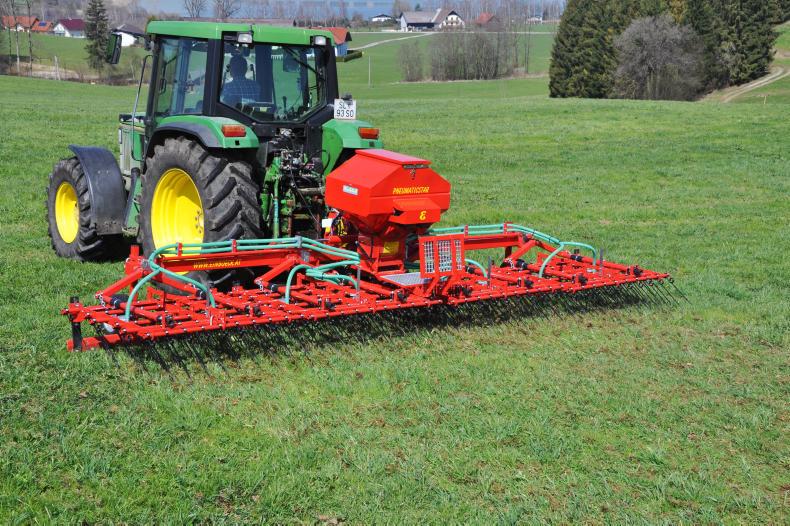
Einböck manufactures a range of grassland harrow and seeder combinations ranging from 3m-12m working widths.
EinbÖck
The Austrian-built Einböck equipment range is imported into Ireland by PJ Callan, Ardee, Co Louth.
Einböck manufactures a number of machines for soil preparation and grassland care. The Pneumaticstar Pro is ideally suited for both stitching into an existing sward or directly into ploughed and tilled ground.
It is available in three working widths – 3m, 6m and 12m. The six-row tine arrangement of the Pneumaticstar carries 60 tines for each 1.5m working width.
Tine aggressiveness can be adjusted per section by a central lever, in one of five preset positions.
Each tine has a line distance of 2.5cm to provide an even dethatching effect, pulling out dead unwanted grass and to encourage tillering of the existing sward.
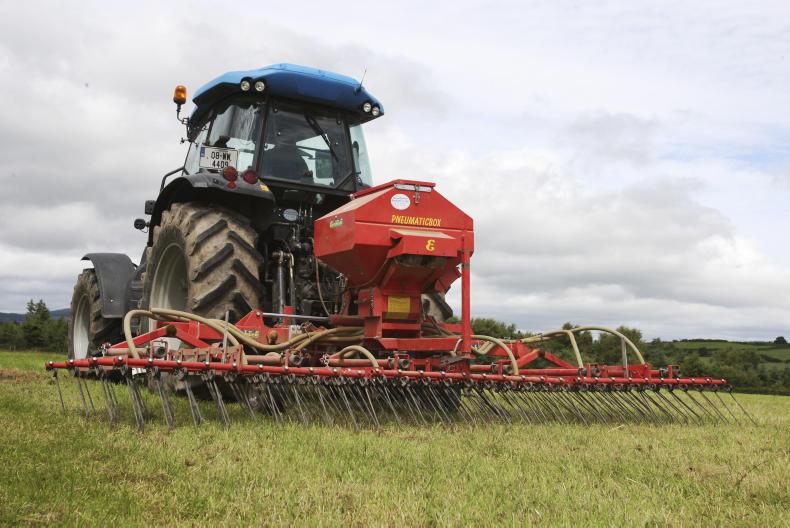
The dethatching or scratching effect also exposes a degree of soil, which helps cover the seed.
Either electronic or manual dosing pneumatic seeder units are available and both these seeders can be purchased as standalone units for retrofit on to other machines.
Both seeder types can apply rates from 1kg/ha to 300kg/ha. The manual seeder’s dosing unit is ground driven via support wheel.
Einböck also has its Grass Manager and Manager Pro tine harrow options, which are fitted with strong 10mm tines for levelling, as well as scarifying, helping remove dead material such as moss and old grasses from the sward. Prices for the Einböck Pnuematicstar Pro start at €6,550 plus VAT while the standalone Pneumatic seeders start at €3,875 plus VAT.
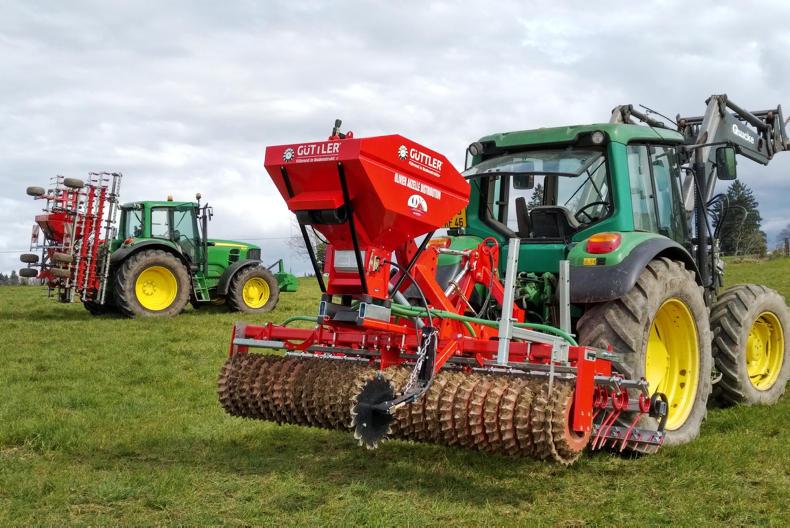
The Güttler GreenMaster and GreenSeeder units.
GÜttler
The German-built Güttler equipment range is imported into Ireland by Phil Traynor based in Dungarvan, Co Waterford. Güttler supplies a number of equipment ranges for cultivation and grassland management situations. Two of its more popular machines aimed for rejuvenating old pastures are the GreenMaster and GreenSeeder series. Both machines are modular in design, meaning tools can be added or removed depending on the situation.
The GreenMaster sees a twin-row tine arrangement, consisting of 12mm tines, with spacings of 75mm. Following the tine rows is a self-cleaning prism roller. Two roller options are available, the Mediana 30 or the Metador 30, the difference being roller ring diameters.
Seeding is carried out using Güttler’s own pneumatic seeder, which is also available as a standalone retrofit unit.
Either hydraulic drive or mechanical drive options are available. Working widths vary from 2.5m to 3m right up to larger trailed 7.5m units.
The GreenSeeder is different, in that it is just a tine harrow and pneumatic seeder solution with no prism roller. The unit is also fitted with two rows of 12mm tines, with 75mm spacings. Two working widths are available – 6m and 7m. Both units are hydraulic-folding for road transport.
The GreenMaster and GreenSeeder are available with or without seeding units and both have the flexibility to have additional tools added or removed, such as levelling boards, etc. Both 200l and 400l seed hoppers are available for the machines.
Prices for the GreenMaster start at €13,090 plus VAT, while the GreenSeeder has a starting price of €14,360 plus VAT.
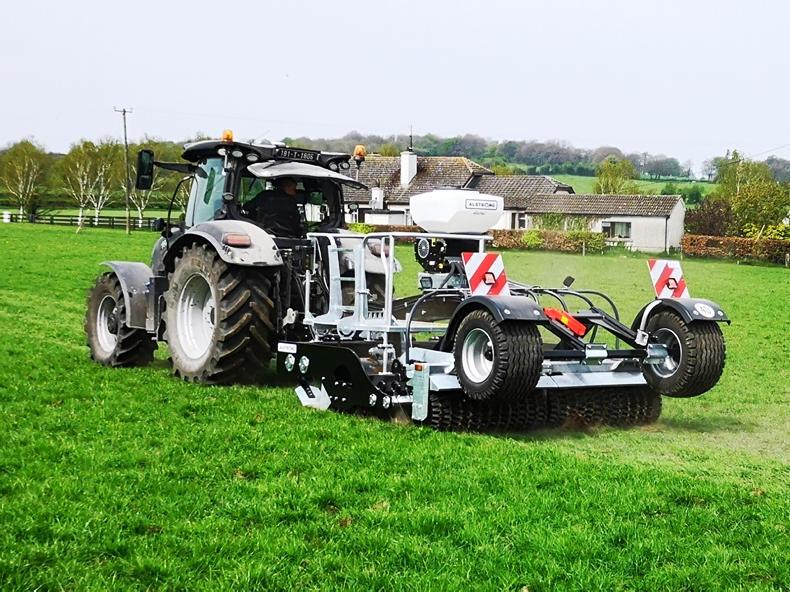
The Actus T is Alstrong's multi tool, one pass solution for rejuvenating old pastures.
Alstrong
Located in Co Galway, Alstrong offers the Actus T. The Actus T not only stitches in new seed, but also provides aeration to the soil thanks to its spiked roller. In addition, the Actus T can be used on ploughed ground. This more-sophisticated trailed unit is designed to be a one-pass solution for rejuvenating old pastures.
The firm says five operations are carried out in just one pass. Up front are two rows of sprung levelling boards, designed to scratch the surface and remove dead material, as well as loosen a small amount of soil.
Spiked drum
Following this is a spiked drum fitted with 80mm blades designed to both repair poached soil and penetrate the surface, aerating the root zone. After this, the pneumatic seeder distributes seed, before two rows of 12mm tines act similarly to the levelling boards, as well as helping promote tillering of the existing pasture.
Finally, the prismatic roller covers the seed, consolidating the seedbed and finishing the process.
The spiked drum can be filled with water, increasing the unit’s dry weight of 4.5t to a laden weight of 5.2t. A minimum power requirement of 120hp is recommended.
The Auctus T starts at a price of €25,000 plus VAT.
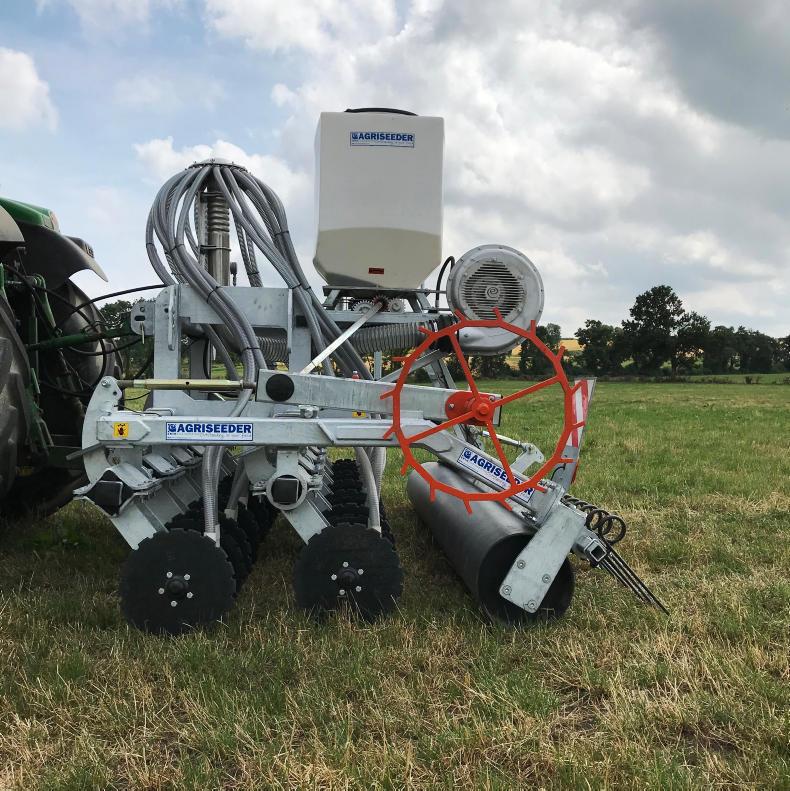
The Erth Agriseeder directly drills seed into the ground of exisitng pastures using a disc and coulter setup.
Erth
Based in Co Down, Erth Engineering offers what it calls an Agriseeder. The typical 3m version has three separate 1m-wide frame sections. Each section applies its own independent surface pressures.
The three sections are pressurised individually through its own hydraulic ram, which is linked to an overall hydraulic pressure system.
The 3m drill has 24 rows. This offers row spacings of 125mm and a row width of 7mm. It is equipped with a 300l hopper.
Its mushroom distribution head is transparent, meaning the operator can see that there is still seed in the distribution tubes.
This seed distribution unit is located between the tractor and the hopper. Erth Engineering sources the metering unit from Kverneland.
The drill is fitted with serrated discs. These discs cut a narrow slit 10mm to 15mm into the surface. The seed is then placed in the ground via the coulters.
These coulters come with replaceable tungsten carbide tips and are loaded against the discs by rubber washers.
Once the seed has been placed in the ground, it is followed by a smooth roller. The roller also serves as a depth control unit.
As the drill is ground-drive, the forward speed and the seed metering system are controlled by a wheel attached to the roller unit.
Although a slightly more complex machine with a different working principle to some of the other options, the Agriseeder has a starting price of €22,000 plus VAT.
Palatine
After developing a tined grass harrow for use on their own family farm, some encouragement by neighbours led Ken Smyth to set up Co Limerick-based Palatine Engineering. Palatine offers grass harrows with working widths of 3m, 4.5m and 6m. These machines have transport widths starting at 2.5m.
Palatine offers the grass harrow with or without a seeder. Depending on the customers’ requirements, the firm can fit a small spinner broadcaster to the harrow or an air seeder. Palatine explained that the spinner broadcaster offers a very cost-effective setup, which helps to increase the versatility of the harrow.
Meanwhile, the air seeder is generally fitted to wider machines and offers more even seed placement and less disturbance from the wind. The air seeders are offered in both fixed and variable ground speeds.
The Palatine harrows come with galvanised tine frames and have oversized main pivots with greaseable replaceable bushes. Its ‘Terra~Link’ design allows the tine units to follow the contours of the land. The main frame is shared between GH120, GH180 and GH240 versions, so it is possible to convert to different widths at a later stage if desired.
The harrows are designed with multiple tine angle positions to suit differing conditions and crops. The smaller GH120 and GH180 have two depth-control wheels, while the GH240 has four as standard. The transport latch for folding is controlled from the cab. The 3m GH120 is priced at €3,400 plus VAT.

APV harrow and seeder units can be configured to be mounted on the tractors front or rear.
APV
Probably best known on Irish soils for its proven air seeders, APV also offers a grassland tine harrow which can be equipped with an air seeder.
The basic APV grass harrow comprises four rows of tines - two rows of strong and two rows of slightly cranked spring tines. The two front rows of 10mm or 12mm tines are designed to tear the sward and free the grassland of weeds and matting. Meanwhile, the two rear rows of 8mm tines separate the soil from the torn weeds, helping to produce a fine soil and, for some applications, work seed into the soil.
The harrow rests on swivel and lockable front feeler wheels, which also helps it to follow the contours of the ground.
A spring-mounted levelling plate is available as an optional extra, which helps to level out any unevenness.
This plate is height-adjustable thanks to two bolts at the hole pattern. The levelling plate is also guided by the feeler wheels.
If desired, it is possible to combine the grassland harrow with different APV air seeders. The APV harrow can also be configured to fit on to the front of a tractor if required.
APV offers the machine in two working widths – either 3m or 6m. The 3m machine has 40 tines on the front row and 60 on the rear. It weighs in at 530kg. Meanwhile, the 6m machine has 80 tines on the front row and 120 on the rear. It weighs in at 1,050kg.
The 3m machine has a starting price of €10,200 plus VAT.
With margins as tight as ever,, modern livestock systems need to grow and utilise as much grass as possible. There are a number of methods in which old or underperforming grassland can be rejuvenated. After all, it pays to keep grassland right given that it is the cheapest source of feed for farmers.
Telltale signs that a sward is in need of attention include poor grass quality, slower response to fertiliser, lower yields and a presence of weeds. Poor weather conditions, poaching and traffic from heavy machinery can lead to soil compaction.
If you’re looking to give your pasture a new lease of life, the traditional plough, till and sow method is not the only option. As with most situations, there is no one-fits-all solution. Depending on the situation, methods such as stitching in and soil aeration can provide good results at a reduced cost.
In some cases, ploughing may be the only option in scenarios where land has not been cultivated for a number of years. Ploughing helps to open up the soil, improving aeration and natural drainage.
Turnaround times
However, stitching or direct drilling methods have many benefits which include quicker turnaround times from seeding to grazing and they generally work out cheaper in comparison with the traditional methods. A major benefit of stitching or direct drilling is the firmer seedbed allowing greater stock-carrying capacity. Post-emergence weed issues tend to be less of a problem with stitching too. Some older swards will often still have good levels of perennial ryegrass and can be improved by stitching in.
On the other hand, soil compaction may prove to be the main issue - this is where soil can benefit from aeration and subsoiling processes alone.
Management
However, direct drilling or stitching methods require good management before and after to get the most benefit from the process. It is not just as simple as stitching and hoping for the best. Regardless of the reseed method, good soil fertility is essential for good establishment and persistency of a sward.
There are a vast number of machine types and brand offerings available on the Irish market. We pick out just a sample of offerings to give a taste of what’s available.

Einböck manufactures a range of grassland harrow and seeder combinations ranging from 3m-12m working widths.
EinbÖck
The Austrian-built Einböck equipment range is imported into Ireland by PJ Callan, Ardee, Co Louth.
Einböck manufactures a number of machines for soil preparation and grassland care. The Pneumaticstar Pro is ideally suited for both stitching into an existing sward or directly into ploughed and tilled ground.
It is available in three working widths – 3m, 6m and 12m. The six-row tine arrangement of the Pneumaticstar carries 60 tines for each 1.5m working width.
Tine aggressiveness can be adjusted per section by a central lever, in one of five preset positions.
Each tine has a line distance of 2.5cm to provide an even dethatching effect, pulling out dead unwanted grass and to encourage tillering of the existing sward.

The dethatching or scratching effect also exposes a degree of soil, which helps cover the seed.
Either electronic or manual dosing pneumatic seeder units are available and both these seeders can be purchased as standalone units for retrofit on to other machines.
Both seeder types can apply rates from 1kg/ha to 300kg/ha. The manual seeder’s dosing unit is ground driven via support wheel.
Einböck also has its Grass Manager and Manager Pro tine harrow options, which are fitted with strong 10mm tines for levelling, as well as scarifying, helping remove dead material such as moss and old grasses from the sward. Prices for the Einböck Pnuematicstar Pro start at €6,550 plus VAT while the standalone Pneumatic seeders start at €3,875 plus VAT.

The Güttler GreenMaster and GreenSeeder units.
GÜttler
The German-built Güttler equipment range is imported into Ireland by Phil Traynor based in Dungarvan, Co Waterford. Güttler supplies a number of equipment ranges for cultivation and grassland management situations. Two of its more popular machines aimed for rejuvenating old pastures are the GreenMaster and GreenSeeder series. Both machines are modular in design, meaning tools can be added or removed depending on the situation.
The GreenMaster sees a twin-row tine arrangement, consisting of 12mm tines, with spacings of 75mm. Following the tine rows is a self-cleaning prism roller. Two roller options are available, the Mediana 30 or the Metador 30, the difference being roller ring diameters.
Seeding is carried out using Güttler’s own pneumatic seeder, which is also available as a standalone retrofit unit.
Either hydraulic drive or mechanical drive options are available. Working widths vary from 2.5m to 3m right up to larger trailed 7.5m units.
The GreenSeeder is different, in that it is just a tine harrow and pneumatic seeder solution with no prism roller. The unit is also fitted with two rows of 12mm tines, with 75mm spacings. Two working widths are available – 6m and 7m. Both units are hydraulic-folding for road transport.
The GreenMaster and GreenSeeder are available with or without seeding units and both have the flexibility to have additional tools added or removed, such as levelling boards, etc. Both 200l and 400l seed hoppers are available for the machines.
Prices for the GreenMaster start at €13,090 plus VAT, while the GreenSeeder has a starting price of €14,360 plus VAT.

The Actus T is Alstrong's multi tool, one pass solution for rejuvenating old pastures.
Alstrong
Located in Co Galway, Alstrong offers the Actus T. The Actus T not only stitches in new seed, but also provides aeration to the soil thanks to its spiked roller. In addition, the Actus T can be used on ploughed ground. This more-sophisticated trailed unit is designed to be a one-pass solution for rejuvenating old pastures.
The firm says five operations are carried out in just one pass. Up front are two rows of sprung levelling boards, designed to scratch the surface and remove dead material, as well as loosen a small amount of soil.
Spiked drum
Following this is a spiked drum fitted with 80mm blades designed to both repair poached soil and penetrate the surface, aerating the root zone. After this, the pneumatic seeder distributes seed, before two rows of 12mm tines act similarly to the levelling boards, as well as helping promote tillering of the existing pasture.
Finally, the prismatic roller covers the seed, consolidating the seedbed and finishing the process.
The spiked drum can be filled with water, increasing the unit’s dry weight of 4.5t to a laden weight of 5.2t. A minimum power requirement of 120hp is recommended.
The Auctus T starts at a price of €25,000 plus VAT.

The Erth Agriseeder directly drills seed into the ground of exisitng pastures using a disc and coulter setup.
Erth
Based in Co Down, Erth Engineering offers what it calls an Agriseeder. The typical 3m version has three separate 1m-wide frame sections. Each section applies its own independent surface pressures.
The three sections are pressurised individually through its own hydraulic ram, which is linked to an overall hydraulic pressure system.
The 3m drill has 24 rows. This offers row spacings of 125mm and a row width of 7mm. It is equipped with a 300l hopper.
Its mushroom distribution head is transparent, meaning the operator can see that there is still seed in the distribution tubes.
This seed distribution unit is located between the tractor and the hopper. Erth Engineering sources the metering unit from Kverneland.
The drill is fitted with serrated discs. These discs cut a narrow slit 10mm to 15mm into the surface. The seed is then placed in the ground via the coulters.
These coulters come with replaceable tungsten carbide tips and are loaded against the discs by rubber washers.
Once the seed has been placed in the ground, it is followed by a smooth roller. The roller also serves as a depth control unit.
As the drill is ground-drive, the forward speed and the seed metering system are controlled by a wheel attached to the roller unit.
Although a slightly more complex machine with a different working principle to some of the other options, the Agriseeder has a starting price of €22,000 plus VAT.
Palatine
After developing a tined grass harrow for use on their own family farm, some encouragement by neighbours led Ken Smyth to set up Co Limerick-based Palatine Engineering. Palatine offers grass harrows with working widths of 3m, 4.5m and 6m. These machines have transport widths starting at 2.5m.
Palatine offers the grass harrow with or without a seeder. Depending on the customers’ requirements, the firm can fit a small spinner broadcaster to the harrow or an air seeder. Palatine explained that the spinner broadcaster offers a very cost-effective setup, which helps to increase the versatility of the harrow.
Meanwhile, the air seeder is generally fitted to wider machines and offers more even seed placement and less disturbance from the wind. The air seeders are offered in both fixed and variable ground speeds.
The Palatine harrows come with galvanised tine frames and have oversized main pivots with greaseable replaceable bushes. Its ‘Terra~Link’ design allows the tine units to follow the contours of the land. The main frame is shared between GH120, GH180 and GH240 versions, so it is possible to convert to different widths at a later stage if desired.
The harrows are designed with multiple tine angle positions to suit differing conditions and crops. The smaller GH120 and GH180 have two depth-control wheels, while the GH240 has four as standard. The transport latch for folding is controlled from the cab. The 3m GH120 is priced at €3,400 plus VAT.

APV harrow and seeder units can be configured to be mounted on the tractors front or rear.
APV
Probably best known on Irish soils for its proven air seeders, APV also offers a grassland tine harrow which can be equipped with an air seeder.
The basic APV grass harrow comprises four rows of tines - two rows of strong and two rows of slightly cranked spring tines. The two front rows of 10mm or 12mm tines are designed to tear the sward and free the grassland of weeds and matting. Meanwhile, the two rear rows of 8mm tines separate the soil from the torn weeds, helping to produce a fine soil and, for some applications, work seed into the soil.
The harrow rests on swivel and lockable front feeler wheels, which also helps it to follow the contours of the ground.
A spring-mounted levelling plate is available as an optional extra, which helps to level out any unevenness.
This plate is height-adjustable thanks to two bolts at the hole pattern. The levelling plate is also guided by the feeler wheels.
If desired, it is possible to combine the grassland harrow with different APV air seeders. The APV harrow can also be configured to fit on to the front of a tractor if required.
APV offers the machine in two working widths – either 3m or 6m. The 3m machine has 40 tines on the front row and 60 on the rear. It weighs in at 530kg. Meanwhile, the 6m machine has 80 tines on the front row and 120 on the rear. It weighs in at 1,050kg.
The 3m machine has a starting price of €10,200 plus VAT.












 This is a subscriber-only article
This is a subscriber-only article




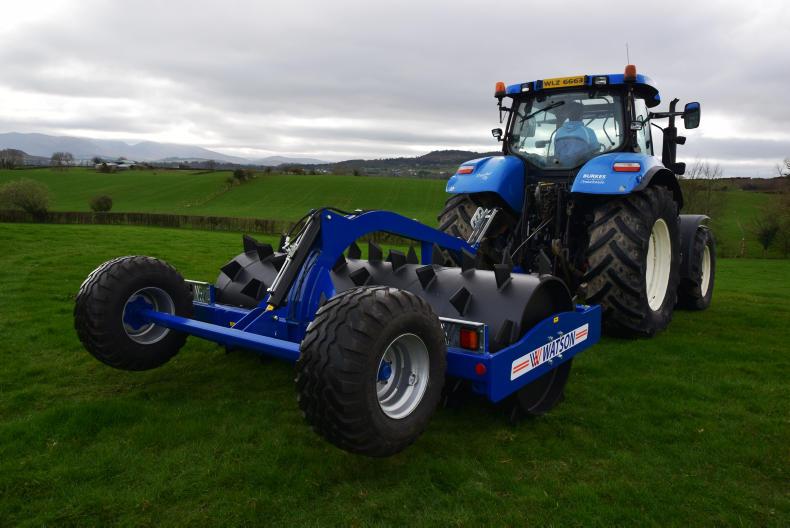



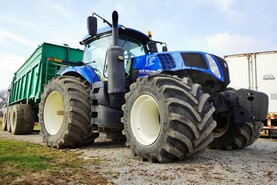
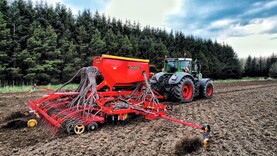
SHARING OPTIONS: